|
| ID |
Image |
Oil Pantings, Sorted from A to Z |
Other Information |
| 62828 |
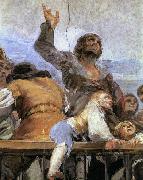 |
The Miracle of St Anthony |
1798 Fresco San Antonio de la Florida, Madrid Angels do not fall out of the sky; people, however, need a balustrade. Goya uses it to emphasize that the earthly world extends as far as the edge of the cupola, which is usually claimed by the Church |
| 62829 |
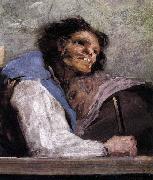 |
The Miracle of St Anthony |
1798 Fresco, width of detail 50 cm San Antonio de la Florida, Madrid Artist: GOYA Y LUCIENTES, Francisco de Title: The Miracle of St Anthony (detail) , painting Date: 1801-1850 Spanish : religious |
| 62830 |
 |
The Miracle of St Anthony |
1798 Fresco, width of detail 50 cm San Antonio de la Florida, Madrid Artist: GOYA Y LUCIENTES, Francisco de Title: The Miracle of St Anthony (detail) , painting Date: 1801-1850 Spanish : religious |
| 28075 |
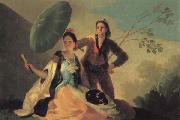 |
The Parasol |
mk61
1777
Oil on canvas
104x152cm
|
| 44119 |
 |
The Quail Shoot |
1775
Oil on canvas,
290 x 226 cm |
| 62458 |
 |
The same |
1810-15 Etching and wash, 160 x 221 mm - This is Plate 3 from the series The Disasters of War (Los desastres de la guerra). Author: GOYA Y LUCIENTES, Francisco de Title: The same Form: graphics , 1801-1850 , Spanish , other |
| 44091 |
 |
The Second of May, 1808 |
1814
Oil on canvas,
266 x 345 cm |
| 42742 |
 |
The third May |
MK169
1808 , 1814 oil Paint on cloth 260x345cm |
| 42746 |
 |
The third May |
MK169
1808,1814 oil Paint on cloth 260x345cm |
| 44133 |
 |
The Yard of a Madhouse |
1794
Oil on tinplate,
43,8 x 31,7 cm |
| 62462 |
 |
There was no remedy |
1797-98 Etching and aquatint, 217 x 152 mm - This is Plate 24 from the series Los Caprichos. Those condemned by the Inquisition were publicly paraded wearing a distinctive conical hat signaling their disgrace.In 1807 a French traveller in valencia watched an alleged witch, "her upper body bared to the waist", being lead through every quarter of the town. Author: GOYA Y LUCIENTES, Francisco de Title: There was no remedy Form: graphics , 1801-1850 , Spanish , other |
| 62478 |
 |
They are hot |
1797-98 Red chalk and red wash, 219 x 153 mm Museo del Prado, Madrid In all probability Goya was a faithful Christian, but he hated the mass of 60.000 Spanish monks as greedy and lazy, as encouraging superstition and as profiting from the work of others. Author: GOYA Y LUCIENTES, Francisco de Title: They are hot! Form: graphics , 1801-1850 , Spanish , study |
| 40649 |
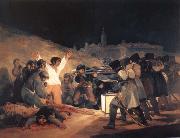 |
Third of May |
mk156
1808
1814
Oil on canvas
266x345cm
|
| 62834 |
 |
Tiburcio |
1820 Oil on canvas, 102 x 81 cm Metropolitan Museum of Art, new York Tiburcio Perez y Cuervo was an architect, a friend of Goya. Artist: GOYA Y LUCIENTES, Francisco de Title: Tiburcio Perez y Cuervo , painting Date: 1801-1850 Spanish : portrait |
| 62465 |
 |
Truth Has Died |
1810-1814 Etching, 175 x 220 mm - This is Plate 79 from the series The Disasters of War (Los desastres de la guerra). In the concluding plates of the Disasters of War are shown the burial of a beautiful young woman, followed by her exhumation or resurrection . Captioned Murio la verdad (Truth has Died), the first shows her body radiant with light as she lies in her grave and a looming priest administers the last rites. In the companion print, Si reucitaria? (Will She Rise Again?), she is exposed, her radiance and beauty faded, her face aged. Still she emits a glow that seems all the greater for the depth of background shadow - and sufficient to throw the crowd of peering ghouls into a frenzy. Here, the parallel hatching of the first etched plate is replaced by radiant lines, inked more intensely as they spread away from the body. Author: GOYA Y LUCIENTES, Francisco de Title: Truth Has Died (Murio la verdad) Form: graphics , 1801-1850 , Spanish , other |
| 44105 |
 |
Two Monks |
1821-23
144 x 66 cm |
| 44102 |
 |
Two Women and a Man |
1820-21
125 x 66 cm |
| 44106 |
 |
Two Women Eating |
1821-23
53 x 85 cm |
| 62470 |
 |
Unfortunate Events in the Front Seats of the Ring of Madrid |
245 x 355 mm - This is Plate 21 from the series Tauromaquia. A bull has leapt over the barrier and killed and injured a number of spectators. Goya leaves the left half of the picture empty, infringing the rules of compositional harmony. A number of spectators are nevertheless flinging themselves from right to left: out of the static balance, Goya develops a dynamic one. Author: GOYA Y LUCIENTES, Francisco de Title: Unfortunate Events in the Front Seats of the Ring of Madrid Form: graphics , 1801-1850 , Spanish , other |
| 62482 |
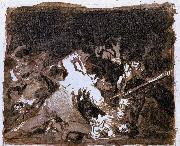 |
War scene |
1810-12 Brush and sepia wash, 150 x 195 mm Museo del Prado, Madrid A sombre scene, one of the designs that Goya did not turn into an etching for The Disasters of War. Author: GOYA Y LUCIENTES, Francisco de Title: War scene Form: graphics , 1801-1850 , Spanish , other |
| 44081 |
 |
Water Carrier |
1808-12
Oil on canvas,
68 x 52 cm |
| 62460 |
 |
What courage |
1810-15 Etching and aquatint, 155 x 208 mm - This is Plate 7 from the series The Disasters of War (Los desastres de la guerra). Goya reacted to the struggle against the French with The Disasters of War, his second great cycle of etchings after Los Caprichos. It extends to over 80 plates, but includes only few acts of heroism, such as that of the young woman who fires the cannon after all the men are dead. Author: GOYA Y LUCIENTES, Francisco de Title: What courage! Form: graphics , 1801-1850 , Spanish , other |
| 62463 |
 |
What more can one do |
1812-15 Etching and aquatint, 158 x 208 mm - This is Plate 33 from the series The Disasters of War (Los desastres de la guerra). French soldiers castrate or kill a defenceless man. This is another scene that the artist, living in Madrid, probably did not see at first hand. Brutality and death fired his imagination. Author: GOYA Y LUCIENTES, Francisco de Title: What more can one do? Form: graphics , 1801-1850 , Spanish , other |
| 62483 |
 |
Who Can Think of It |
1814-23 Sepia wash and Indian ink, 205 x 142 mm Museo del Prado, Madrid This graphics belongs to Album C. Author: GOYA Y LUCIENTES, Francisco de Title: Who Can Think of It? Form: graphics , 1801-1850 , Spanish , other |
| 62466 |
 |
Will She Rise Again |
1810-1814 Etching, 175 x 220 mm - This is Plate 80 from the series The Disasters of War (Los desastres de la guerra). In the concluding plates of the Disasters of War are shown the burial of a beautiful young woman, followed by her exhumation or resurrection . Captioned Murio la verdad (Truth has Died), the first shows her body radiant with light as she lies in her grave and a looming priest administers the last rites. In the companion print, Si reucitaria? (Will She Rise Again?), she is exposed, her radiance and beauty faded, her face aged. Still she emits a glow that seems all the greater for the depth of background shadow - and sufficient to throw the crowd of peering ghouls into a frenzy. Here, the parallel hatching of the first etched plate is replaced by radiant lines, inked more intensely as they spread away from the body |
| 44139 |
 |
Witches in the Air |
1797-98
Oil on canvas,
43,5 x 31,5 cm |
| 44103 |
 |
Witches Sabbath |
1820-23
140 x 438 cm |
| 28590 |
 |
Witches'Sabbath of The Great Goat |
mk61
c.1820-1822
Oil on canvas
140x438cm
|
| 44128 |
 |
Witches- Sabbath |
1789
Oil on canvas,
43 x 30 cm |
| 62481 |
 |
Woman Hitting Another Woman with a Shoe |
1812-23 Sepia wash, 205 x 141 mm Museum Boijmans van Beuningen, Rotterdam This graphics is from Album F. Author: GOYA Y LUCIENTES, Francisco de Title: Woman Hitting Another Woman with a Shoe Form: graphics , 1801-1850 , Spanish , other |
| 62480 |
 |
You'll see later |
1803-12 Indian ink and pen on pink paper, 266 x 187 mm Metropolitan Museum of Art, New York This sketch shows a burly lower-class man drinking greedily from a leather bottle. Ha has clearly been arguing with his wife, and Goya shows a moment of discord and dramatic action. With just a few precise brushstrokes and without any prior drawing, Goya conveys an emotionally charged expression. Author: GOYA Y LUCIENTES, Francisco de Title: You'll see later (Despu?s lo veras) Form: graphics , 1801-1850 , Spanish , study |
|
|
|
Prev 1 2
|
|
| Francisco de goya y Lucientes
|
| b. March 30, 1746, Fuendetodos, Spain--d. April 16, 1828,
Goya is considered the 18th Century's foremost painter and etcher of Spanish culture, known for his realistic scenes of battles, bullfights and human corruption. Goya lived during a time of upheaval in Spain that included war with France, the Inquisition, the rule of Napoleon's brother, Joseph, as the King of Spain and, finally, the reign of the Spanish King Ferdinand VII. Experts proclaim these events -- and Goya's deafness as a result of an illness in 1793 -- as central to understanding Goya's work, which frequently depicts human misery in a satiric and sometimes nightmarish fashion. From the 1770s he was a royal court painter for Charles III and Charles IV, and when Bonaparte took the throne in 1809, Goya swore fealty to the new king. When the crown was restored to Spain's Ferdinand VII (1814), Goya, in spite of his earlier allegiance to the French king, was reinstated as royal painter. After 1824 he lived in self-imposed exile in Bordeaux until his death, reportedly because of political differences with Ferdinand. Over his long career he created hundreds of paintings, etchings, and lithographs, among them Maya Clothed and Maya Nude (1798-1800); Caprichos (1799-82); The Second of May 1808 and The Third of May 1808 (1814); Disasters of War (1810-20); and The Black Paintings (1820-23).
. Related Artists to : | Jan Matejko | Joseph Albrier | Ljubov Popova | BARTOLOMEO, Fra | Charles Amedee Philippe Van Loo | |

|
|